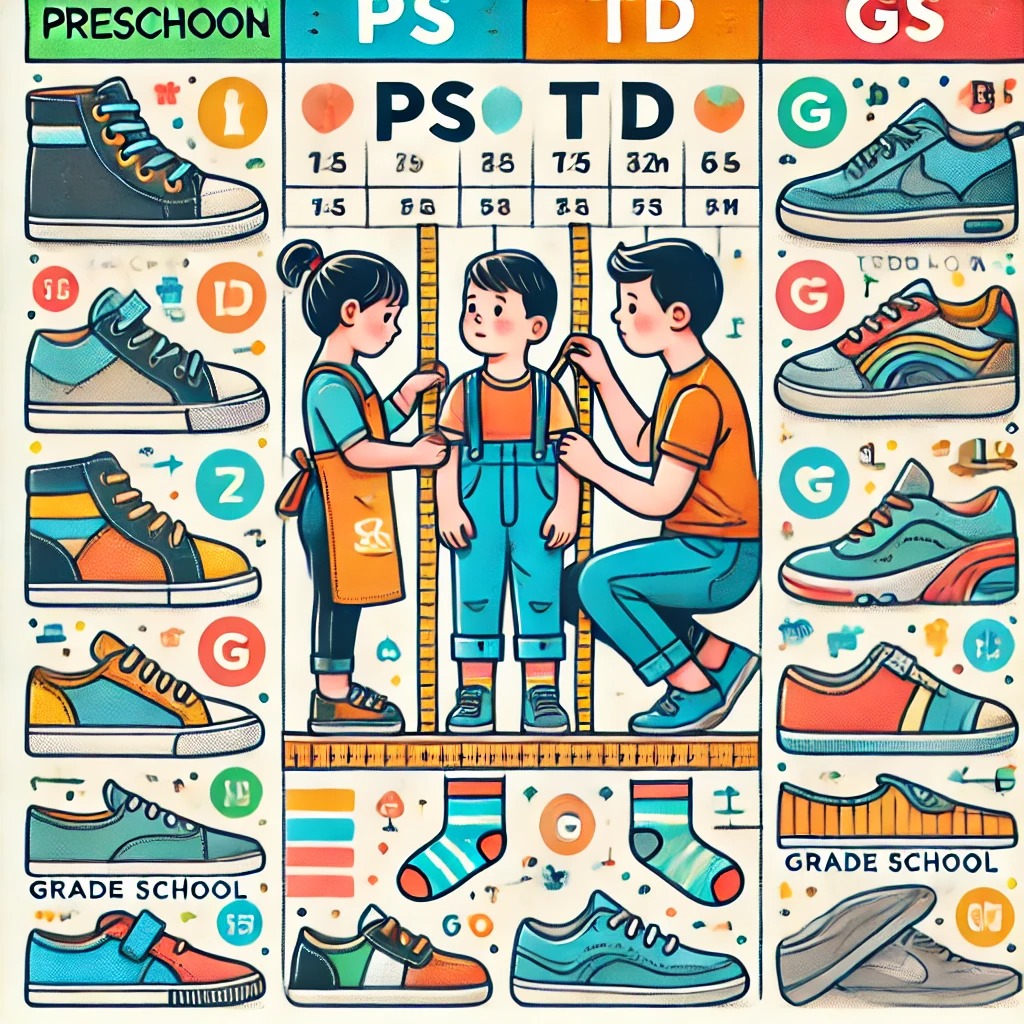When purchasing shoes for your child, understanding the terminology used in shoe sizes can be confusing. One term you might have encountered is PS. You’re not alone if you’re wondering, “What does PS mean in shoes?”. This abbreviation plays a significant role in ensuring your little one’s footwear fits just right. In this guide, we’ll explore what PS means in the world of kids’ shoes, how to measure for the perfect fit, and how to navigate the various shoe size categories for children.
What Does PS Mean in Shoes?
PS stands for Preschool Size. In the world of kids’ shoe sizing, PS refers to a specific range of shoe sizes designed for preschool-aged children, typically between 3 and 5 years old. These sizes are part of a broader system of shoe sizes that also includes toddler (T), youth (Y), and infant (I) sizes.
In simple terms, PS shoes are designed for children who are no longer in toddler shoes but are not yet ready for the larger youth sizes. Parents must understand where PS shoes fit into the sizing system and how they can ensure their child gets the most comfortable fit.
Understanding Shoe Sizing for Kids
Shoe sizing for children can be tricky because it doesn’t follow the same system as adult shoe sizes. Children’s feet proliferate, and their shoes must change as they age. The most common shoe size categories for kids include:
Infant Sizes (0-4): These are shoes for babies, typically ranging from 0 to 4 years old.
Toddler Sizes (T) (4-10): Toddler shoes typically cover kids ages 1 to about 3.
Preschool Sizes (PS) (10-13): This range is for children between the ages of 3 and 5.
Youth Sizes (Y) (1-7): Youth shoes are typically worn by kids aged six and older, or those whose feet have grown out of preschool sizes.
Understanding where PS fits into this system is key for finding the right shoe for your child. PS shoes typically start at a size 10 and increase to size 13, then transition into youth sizes.
PS Shoe Size Explained for Parents
As a parent, ensuring your child’s shoes fit properly is crucial for their comfort and development. PS-sized shoes are specifically crafted to meet the needs of preschoolers whose feet are proliferating. The fit should not be too tight or loose when buying PS shoes. Shoes that are too tight can cause discomfort and limit foot growth, while shoes that are too loose can cause your child to trip or feel unsteady.
Here are some essential things to consider when buying PS shoes:
Width and Arch Support: Ensure the boots have enough width to accommodate your child’s foot shape. Preschoolers may need shoes with extra arch support to promote healthy foot development.
Fastening Systems: Look for shoes with adjustable straps or velcro to allow easy wearing and ensure a snug fit around the foot.
Comfort: Prioritize cushioned insoles and lightweight materials that promote comfort. Remember, your preschooler will likely be running and playing in these shoes.
Differences Between PS and Other Shoe Sizes
Understanding how PS shoes differ from other children’s sizes is essential. The key differences include:
- PS vs. Toddler Sizes: Toddler shoes are typically smaller than PS sizes. They are designed for younger children whose feet have just started growing. In contrast, PS shoes are more significant and cater to children with more developed feet.
- PS vs. Youth Sizes: Once a child outgrows the PS range, they transition into youth sizes. Youth sizes typically start at 1, more significant than the most considerable PS (13). PS sizes are narrower, as they are meant for preschool-aged children still in the early stages of foot development.
How to Measure Your Child’s Foot for PS Shoes
Correctly measuring your child’s foot is essential when buying shoes in the PS range. Here’s how to do it:
Get the Right Tools: Use a soft measuring tape or a foot measurement tool. You can also place a piece of paper on the floor and have your child stand on it.
Measure Both Feet: It’s common for children’s feet to be slightly different, so measure both feet and go with the larger size.
Determine the Length: Have your child stand up and place their foot on the paper or measuring tool. Measure from the tip of the longest toe to the heel.
Check the Width: Measure the width of the foot at the widest part to ensure you’re selecting the correct shoe width.
What to Look for When Buying PS Shoes
When buying PS shoes, consider the following factors to ensure the best fit for your child:
Materials: Look for shoes made of flexible materials that allow your child’s feet to move naturally. Leather or soft fabrics are usually good choices.
Durability: Preschoolers can be harsh on shoes, so look for sturdy, well-made shoes that can handle running, jumping, and playing.
Easy On/Off: Look for shoes with velcro straps, elastic laces, or slip-ons that make it easy for your child to put on and take off their shoes independently.
Breathability: Opt for shoes with breathable materials to prevent your child’s feet from becoming too hot or sweaty.
Final Thoughts on PS Shoe Sizes
Understanding PS shoe sizes is crucial for ensuring your preschooler gets the proper fit and comfort. Whether you’re looking for their first pair of shoes in the PS range or replacing an old pair, it’s important to consider fit, comfort, and durability.
Your child can quickly move, play, and explore with the right size and style. And by understanding the different shoe categories—like toddler, PS, and youth sizes—you can make an informed decision when shopping for your child’s footwear.
To enhance your child’s accessories, explore this YSL Lip Volupte Tint-in-Balm for the ultimate lip care to complement their style.
Common FAQs About PS Shoes
Q: How do PS sizes compare to toddler or youth sizes?
A: PS sizes are designed for preschoolers, typically around ages 3 to 5. Toddler sizes (T) are smaller, while youth sizes (Y) are more significant and meant for older children.
Q: How often should I measure my child’s feet for PS shoes?
A: Children’s feet grow quickly, so it’s recommended that they be measured every 3-6 months to ensure the shoes still fit properly.
Q: How do I know if PS shoes are the right fit?
A: The shoe should have about a half-inch of space from the tip of the toe to the end of the shoe. The shoe should be snug around the heel and arch but not tight.

